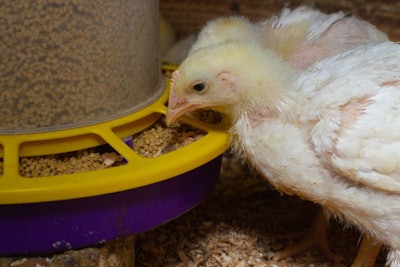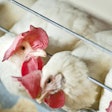
Trusted methods exist and they should be considered first before alternative approaches are tested, usually at considerable cost.
We have been battling with the issue of removing antibiotic growth-promoting agents from animal feeds for more than a decade.
In the U.S., there is even a notion to switch at least part of the broiler production to the no-antibiotics-ever practice, which implies not even sick birds get to be treated with antibiotics. Because coccidiostatic agents are also considered antibiotics in the U.S., there is a tremendous upheaval in the industry as there are no real alternatives to these. Fortunately, this is (still) not the case in the EU and elsewhere.
Nevertheless, this discussion only applies to antibiotics that attack microbes, and not coccidia. Thus, based on long experiences in the field and numerous studies, one can start looking safely to the following six ingredients/additives before considering newer, alternative and often more costly approaches.
-
Organic acids
This technology is decades old and it has been proven that adding enough organic acids can replace antibiotics, at least in healthy birds. That is, organic acids can replace the growth-promoting effect of antibiotics; they cannot cure birds suffering from bacterial diseases. Most importantly, organic acids control the growth of bacteria best when used in blends, and at appropriately high dosages – at least higher than is the average practice in the industry today (0.1-0.3%).
What acids to use remains a trade secret or the recipe of preference for each nutritionist, but as each acid works best against a type of microorganism, it takes little research to find a suitable blend for the type of problems existing on each farm.
Finally, it appears that organic acids work even better when combined with other methods of controlling gut microbiota, such as with phytogenic compounds, but this is still an area of considerable investigation as the types of phytogenics remain limited to a very narrow range compared with their abundance in nature.
-
Copper and zinc
Zinc oxide, unfortunately, does not work in broilers as it does in piglets. But, copper sulfate does, and it is part of the remedy in replacing antibiotics. Today, it is (still) allowed in limited doses and, being relatively inexpensive, it makes sense to use it.
Modern forms of copper and zinc, used at low dosages, should not be ignored as they offer substantial benefits in terms of performance, manufacturing and premix stability – aspects often ignored. Each country (or region) has specific laws regulating the levels and types of these minerals allowed in broiler diets, and it is a good advice always to check with authorities (or suppliers) before using such additives.
-
Probiotics
The majority of poultry nutritionists in most annual nutrition polls run by WATT have ranked probiotics as the No. 1 choice when it comes to spending money finding alternatives to antibiotics.
Although these products do not harm harmful bacteria, they increase the population of beneficial ones in expectation of excluding the “bad” ones through sheer competition for nutrients and space. Not all products are created equal and this could not have been truer in the case of probiotics.
These products work best when combined with a form of “feed” for these alien micro-organisms forcibly introduced into the gut’s natural microflora. However, this whole synergistic effect remains ignored by the prebiotic manufacturers.
-
Feed-grade amino acids
These of course cannot harm bacteria, nor even help them as they are almost completely absorbed in the small intestine, long before they reach the main habitat of gut microbiota.
But they have a very prominent – albeit little recognized – place in every antibiotic-free nutrition program. They allow crude protein (that contains excess amino acids that are not needed for growth) to be lowered (by as much as four percentage points). This deprives pathogenic bacteria – which thrive on protein – from their main nutrient source.
Beneficial bacteria require less protein and more carbohydrates, going back to the previous section where we need to find a way to feed the “good” bacterial, only. Lamentably, in some parts of the world, commercial final/complete feeds with less protein (even though they may contain enough of the essential amino acids) are looked upon with suspicion, and this removes the most powerful approach from the hands of practicing nutritionists. Hence, the heavy dependence on additives, which often prove to be inadequate in their performance when used alone in this respect.
-
Fiber, but which one?
Most nutritionists, today, agree that we need insoluble fiber (that absorbs excess water) in the upper gut to control flow and water concentration, and fermentable fibers in the lower gut to control good bacteria growth. At least, that is the theory.
There is no consensus on how to measure insoluble and fermentable fiber, although there are many different methods, and this makes matters rather difficult. Even worse, there is absolutely no indication how much of each fiber type is required. And, to complicate matters, some nutritionists abhor insoluble fiber for its laxative effects, whereas others detest fermentable fiber that complicates hind gut disorders in affected birds.
Clearly, there is a need to differentiate the fiber profile for healthy and unhealthy birds, but we are still very far away from any practical conclusions, so all we have is personal experiences.
-
Enzymes
Like amino acids, enzymes do not affect microbes directly. But, in the right diets and at the right combinations and dosages, enzymes can affect the growth of beneficial bacteria by converting hard-to-digest carbohydrates into simpler compounds – thus feeding the good bacteria.
Proteases also reduce the amount of wasted protein by increasing protein digestibility, depriving bad bacteria from their feed. There is a reason why enzymes have been placed last in this list, and it is because their effect is minimal and becomes significant enough only in certain cases, and always in conjunction with other products.
In conclusion, it would be great but naive to expect one single product to replace antibiotics. If such a product existed, we would not be having this discussion now. At best, we can use a combination of approaches and make adjustments as needed. Replacing antibiotics is an expensive practice as alternatives are costly, and the extra cost is not passed to the final consumer with ease. Nevertheless, we must work with what we have and, although we have several working approaches, there are always new offers on the market that deserve testing.














